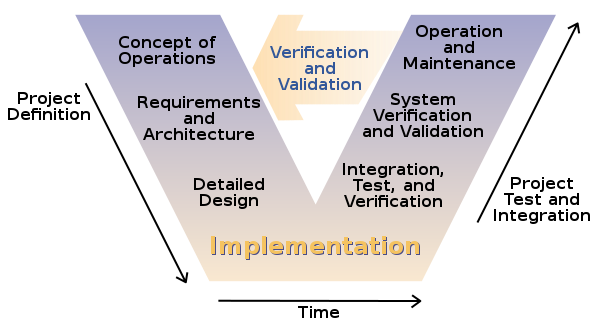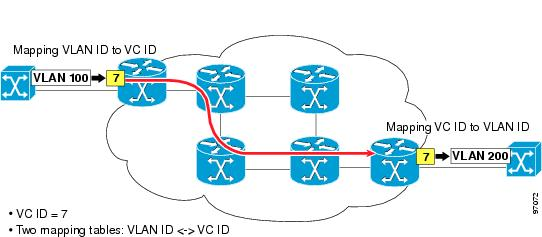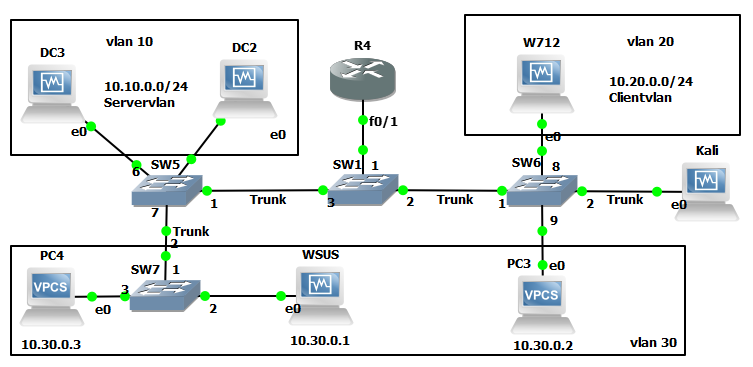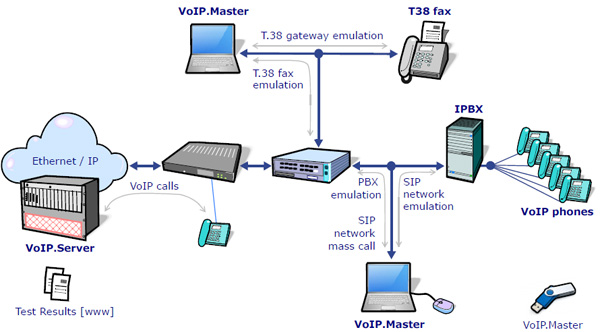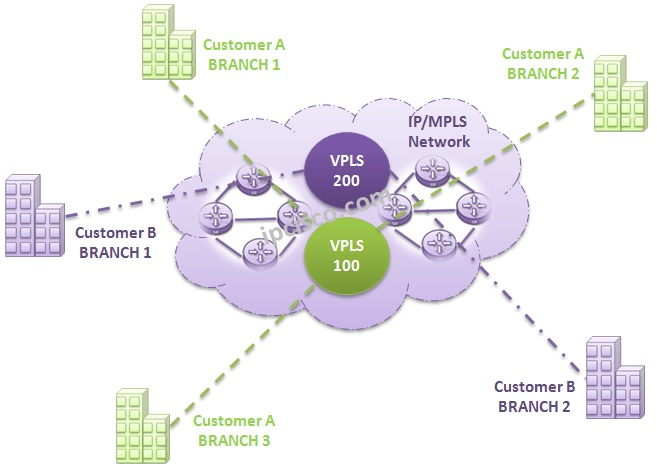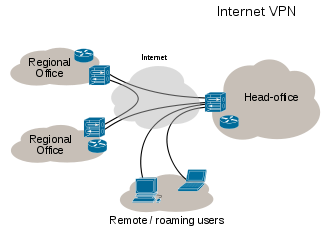V Model | In software development, the V-model represents a development process that may be considered an extension of the waterfall model, and is an example of the more general V-model. Instead of moving down in a linear way, the process steps are bent upwards after the coding phase, to form the typical V shape. The V-Model demonstrates the relationships between each phase of the development life cycle and its associated phase of testing. The horizontal and vertical axes represents time or project completeness (left-to-right) and level of abstraction (coarsest-grain abstraction uppermost), respectively. | |
V.90 | V.90 is an ITU-T recommendation for a modem, allowing 56 kbit/s digital download and 33.6 kbit/s analog upload. It replaced two vendor standards (K56flex and X2) and was designed to allow modems from both prior standards to be flash upgraded to support it. It was developed between March 1998 and February 1999. It is also known as V.Last as it was anticipated to be the last standard for modems operating near the channel capacity of POTS lines to be developed. V.90 is generally used in concert with the V.42bis compression standard. A follow-on standard, V.92, was developed later in 1999 to replace V.90. | |
V.92 | V.92 is an ITU-T recommendation, titled Enhancements to Recommendation V.90, that establishes a modem standard allowing near 56 kb/s download and 48 kb/s upload rates. With V.92 PCM is used for both the upstream and downstream connections; previously 56K modems only used PCM for downstream data. | |
VAD | Voice Activity Detection | Voice activity detection (VAD), also known as speech activity detection or speech detection, is a technique used in speech processing in which the presence or absence of human speech is detected. The main uses of VAD are in speech coding and speech recognition. It can facilitate speech processing, and can also be used to deactivate some processes during non-speech section of an audio session: it can avoid unnecessary coding/transmission of silence packets in Voice over Internet Protocol applications, saving on computation and on network bandwidth. |
VB | Visual Basic | Visual Basic is a third-generation event-driven programming language and integrated development environment (IDE) from Microsoft for its Component Object Model (COM) programming model first released in 1991 and declared legacy during 2008. Microsoft intended Visual Basic to be relatively easy to learn and use. Visual Basic was derived from BASIC and enables the rapid application development (RAD) of graphical user interface (GUI) applications, access to databases using Data Access Objects, Remote Data Objects, or ActiveX Data Objects, and creation of ActiveX controls and objects. |
VBS | VB Script | VBScript ("Microsoft Visual Basic Scripting Edition") is an Active Scripting language developed by Microsoft that is modeled on Visual Basic. It allows Microsoft Windows system administrators to generate powerful tools for managing computers with error handling, subroutines, and other advanced programming constructs. It can give the user complete control over many aspects of their computing environment. |
VC | Virtual Circuit | A virtual circuit (VC) is a means of transporting data over a packet switched computer network in such a way that it appears as though there is a dedicated physical layer link between the source and destination end systems of this data. The term virtual circuit is synonymous with virtual connection and virtual channel. Before a connection or virtual circuit may be used, it has to be established, between two or more nodes or software applications, by configuring the relevant parts of the interconnecting network. After that, a bit stream or byte stream may be delivered between the nodes; hence, a virtual circuit protocol allows higher level protocols to avoid dealing with the division of data into segments, packets, or frames.
|
VCI | Virtual Channel Identifier | The VCI, used in conjunction with the VPI (virtual path indicator), indicates where an ATM cell is to travel over a network. ATM, or asynchronous transfer mode, is a method that many ISPs (Internet Service Providers) use to transfer data to client computers. Because ATM sends packets over fixed channels, the data is easier to track than information sent over the standard TCP/IP protocol. |
VCID | Virtual Circuit/Channel ID | |
VDSL | Very-high-bit-rate digital subscriber line | Very-high-bit-rate digital subscriber line (VDSL) and very-high-bit-rate digital subscriber line 2 (VDSL2)[2] are digital subscriber line (DSL) technologies providing data transmission faster than asymmetric digital subscriber line (ADSL). |
Velocity | At the end of each iteration, the team adds up effort estimates associated with user stories that were completed during that iteration. This total is called velocity. | |
Verifier | Verifies any rework for inspections. | |
Version | A formally released revision of an artifact, recognized by the configuration management process that oversees the artifact. | |
Version Control | Version control is not strictly an Agile "practice" insofar as it is now widespread in the industry as a whole. But it is mentioned here for several reasons. | |
VHDL | The VHSIC Hardware Description Language (VHDL) is a hardware description language (HDL) that can model the behavior and structure of digital systems at multiple levels of abstraction, ranging from the system level down to that of logic gates, for design entry, documentation, and verification purposes. Since 1987, VHDL has been standardized by the Institute of Electrical and Electronics Engineers (IEEE) as IEEE Std 1076; the latest version (as of April 2020) of which is IEEE Std 1076-2019. To model analog and mixed-signal systems, an IEEE-standardized HDL based on VHDL called VHDL-AMS (officially IEEE 1076.1) has been developed. VHDL is named after the United States Department of Defense program that created it, the Very High-Speed Integrated Circuits Program (VHSIC). In the early 1980s, the VHSIC Program sought a new HDL for use in the design of the integrated circuits it aimed to develop. The product of this effort was VHDL Version 7.2, released in 1985. The effort to standardize it as an IEEE standard began in the following year. VHDL is generally used to write text models that describe a logic circuit. Such a model is processed by a synthesis program, only if it is part of the logic design. A simulation program is used to test the logic design using simulation models to represent the logic circuits that interface to the design. This collection of simulation models is commonly called a testbench. A VHDL simulator is typically an event-driven simulator. This means that each transaction is added to an event queue for a specific scheduled time. E.g. if a signal assignment should occur after 1 nanosecond, the event is added to the queue for time +1ns. Zero delay is also allowed, but still needs to be scheduled: for these cases delta delay is used, which represent an infinitely small time step. The simulation alters between two modes: statement execution, where triggered statements are evaluated, and event processing, where events in the queue are processed. VHDL has constructs to handle the parallelism inherent in hardware designs, but these constructs (processes) differ in syntax from the parallel constructs in Ada (tasks). Like Ada, VHDL is strongly typed and is not case sensitive. In order to directly represent operations which are common in hardware, there are many features of VHDL which are not found in Ada, such as an extended set of Boolean operators including nand and nor. VHDL has file input and output capabilities, and can be used as a general-purpose language for text processing, but files are more commonly used by a simulation testbench for stimulus or verification data. There are some VHDL compilers which build executable binaries. In this case, it might be possible to use VHDL to write a testbench to verify the functionality of the design using files on the host computer to define stimuli, to interact with the user, and to compare results with those expected. However, most designers leave this job to the simulator. It is relatively easy for an inexperienced developer to produce code that simulates successfully but that cannot be synthesized into a real device, or is too large to be practical. One particular pitfall is the accidental production of transparent latches rather than D-type flip-flops as storage elements. One can design hardware in a VHDL IDE (for FPGA implementation such as Xilinx ISE, Altera Quartus, Synopsys Synplify or Mentor Graphics HDL Designer) to produce the RTL schematic of the desired circuit. After that, the generated schematic can be verified using simulation software which shows the waveforms of inputs and outputs of the circuit after generating the appropriate testbench. To generate an appropriate testbench for a particular circuit or VHDL code, the inputs have to be defined correctly. For example, for clock input, a loop process or an iterative statement is required. A final point is that when a VHDL model is translated into the "gates and wires" that are mapped onto a programmable logic device such as a CPLD or FPGA, then it is the actual hardware being configured, rather than the VHDL code being "executed" as if on some form of a processor chip. -- (this is a VHDL comment)
/*
this is a block comment (VHDL-2008)
*/
-- import std_logic from the IEEE library
library IEEE;
use IEEE.std_logic_1164.all;
-- this is the entity
entity ANDGATE is
port (
I1 : in std_logic;
I2 : in std_logic;
O : out std_logic);
end entity ANDGATE;
-- this is the architecture
architecture RTL of ANDGATE is
begin
O <= I1 and I2;
library IEEE;
use IEEE.std_logic_1164.all;
use IEEE.numeric_std.all; -- for the unsigned type
entity COUNTER is
generic (
WIDTH : in natural := 32);
port (
RST : in std_logic;
CLK : in std_logic;
LOAD : in std_logic;
DATA : in std_logic_vector(WIDTH-1 downto 0);
Q : out std_logic_vector(WIDTH-1 downto 0));
end entity COUNTER;
architecture RTL of COUNTER is
begin
process(all) is
begin
if RST then
Q <= (others => '0');
elsif rising_edge(CLK) then
if LOAD then
Q <= DATA;
else
Q <= std_logic_vector(unsigned(Q) + 1); --Addition is unsigned, converted back to std_logic_vector
end if;
end if;
end process;
end architecture RTL;
| |
VISP | Virtual ISP | A Virtual ISP (VISP), also known as an Affinity ISP, is an Internet Service Provider (ISP) that resells the resources of existing ISPs under another brand name. |
VLAN | Virtual LAN | A virtual LAN (VLAN) is any broadcast domain that is partitioned and isolated in a computer network at the data link layer (OSI layer 2).[1][2] LAN is the abbreviation for local area network and in this context virtual refers to a physical object recreated and altered by additional logic. VLANs work by applying tags to network packets and handling these tags in networking systems – creating the appearance and functionality of network traffic that is physically on a single network but acts as if it is split between separate networks. In this way, VLANs can keep network applications separate despite being connected to the same physical network, and without requiring multiple sets of cabling and networking devices to be deployed. |
VLR | Visitor Location Register | The Visitor Location Register (VLR) is a database of the MSs (Mobile stations) that have roamed into the jurisdiction of the MSC (Mobile Switching Center) which it serves. Each main base station in the network is served by exactly one VLR (one BTS may be served by many MSCs in case of MSC in pool), hence a subscriber cannot be present in more than one VLR at a time.
|
VM | Virtual Machine | In computing, a virtual machine (VM) is an emulation of a computer system. Virtual machines are based on computer architectures and provide functionality of a physical computer. Their implementations may involve specialized hardware, software, or a combination. |
VOD | Video On Demand | Video on demand is a programming system which allows users to select and watch/listen to video or audio content such as movies and TV shows whenever they choose, rather than at a scheduled broadcast time, the method that prevailed with over-the-air programming during the 20th century. IPTV technology is commonly used to bring VOD to televisions and personal computers.
|
VoIP | Voice over IP | Voice over Internet Protocol (also voice over IP, VoIP or IP telephony) is a methodology and group of technologies for the delivery of voice communications and multimedia sessions over Internet Protocol (IP) networks, such as the Internet. The terms Internet telephony, broadband telephony, and broadband phone service specifically refer to the provisioning of communications services (voice, fax, SMS, voice-messaging) over the public Internet, rather than via the public switched telephone network (PSTN).
|
VoLTE | Voice over Long-Term Evolution | Voice over Long-Term Evolution (VoLTE) is a standard for high-speed wireless communication for mobile phones and data terminals - including IoT devices and wearables. It is based on the IP Multimedia Subsystem (IMS) network, with specific profiles for control and media planes of voice service on LTE defined by GSMA in PRD IR.92. This approach results in the voice service (control and media planes) being delivered as data flows within the LTE data bearer. This means that there is no dependency on (or ultimately, requirement for) the legacy circuit-switched voice network to be maintained. VoLTE has up to three times more voice and data capacity than 3G UMTS and up to six times more than 2G GSM. Furthermore, it frees up bandwidth because VoLTE's packets headers are smaller than those of unoptimized VoIP/LTE. |
Vorbis | Vorbis is a free and open-source software project headed by the Xiph.Org Foundation. The project produces an audio coding format and software reference encoder/decoder (codec) for lossy audio compression. Vorbis is most commonly used in conjunction with the Ogg container format and it is therefore often referred to as Ogg Vorbis. | |
VPI | Virtual Path Identifier | See VCI |
VPLS | Virtual Private LAN Service | Virtual Private LAN Service (VPLS) is a way to provide Ethernet-based multipoint to multipoint communication over IP or MPLS networks. It allows geographically dispersed sites to share an Ethernet broadcast domain by connecting sites through pseudowires. The term 'sites' includes multiplicities of both servers and clients. The technologies that can be used as pseudo-wire can be Ethernet over MPLS, L2TPv3 or even GRE. There are two IETF standards track RFCs (RFC 4761 and RFC 4762) describing VPLS establishment. |
VPN | Virtual Private Network | A virtual private network (VPN) extends a private network across a public network, and enables users to send and receive data across shared or public networks as if their computing devices were directly connected to the private network. Applications running across a VPN may therefore benefit from the functionality, security, and management of the private network. |
VPWS | Virtual Private Wire Service | Virtual Leased Lines (VLL) is a way to provide Ethernet-based point to point communication over IP/MPLS networks. |
VRF | Virtual (VPN) Routing and Forwarding | In IP-based computer networks, (VRF) is a technology that allows multiple instances of a routing table to co-exist within the same router at the same time. Because the routing instances are independent, the same or overlapping IP addresses can be used without conflicting with each other. Network functionality is improved because network paths can be segmented without requiring multiple routers. |
